Japanese Multinationals: Competitiveness in the Global Economy
VerifiedAdded on 2020/02/24
|10
|2262
|47
Report
AI Summary
This report provides an overview of Japan's economic development and the competitiveness of Japanese multinational corporations (MNCs) since the 1960s. It examines the role of science, technology, and innovation in driving the success of Japanese MNCs, highlighting government initiatives like the ...

International relation & global economy 1
International relation & global economy
International relation & global economy
Paraphrase This Document
Need a fresh take? Get an instant paraphrase of this document with our AI Paraphraser
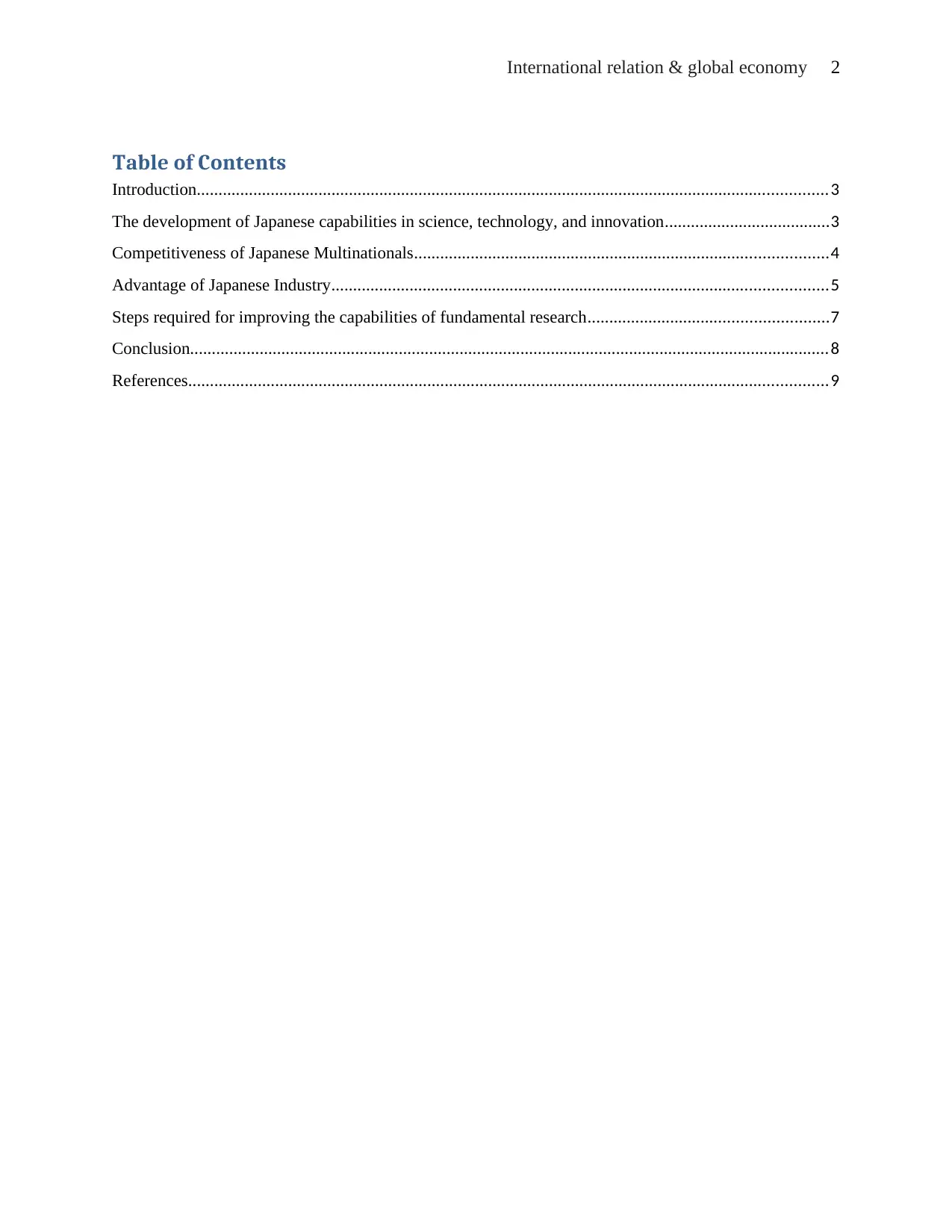
International relation & global economy 2
Table of Contents
Introduction.................................................................................................................................................3
The development of Japanese capabilities in science, technology, and innovation......................................3
Competitiveness of Japanese Multinationals...............................................................................................4
Advantage of Japanese Industry..................................................................................................................5
Steps required for improving the capabilities of fundamental research.......................................................7
Conclusion...................................................................................................................................................8
References...................................................................................................................................................9
Table of Contents
Introduction.................................................................................................................................................3
The development of Japanese capabilities in science, technology, and innovation......................................3
Competitiveness of Japanese Multinationals...............................................................................................4
Advantage of Japanese Industry..................................................................................................................5
Steps required for improving the capabilities of fundamental research.......................................................7
Conclusion...................................................................................................................................................8
References...................................................................................................................................................9
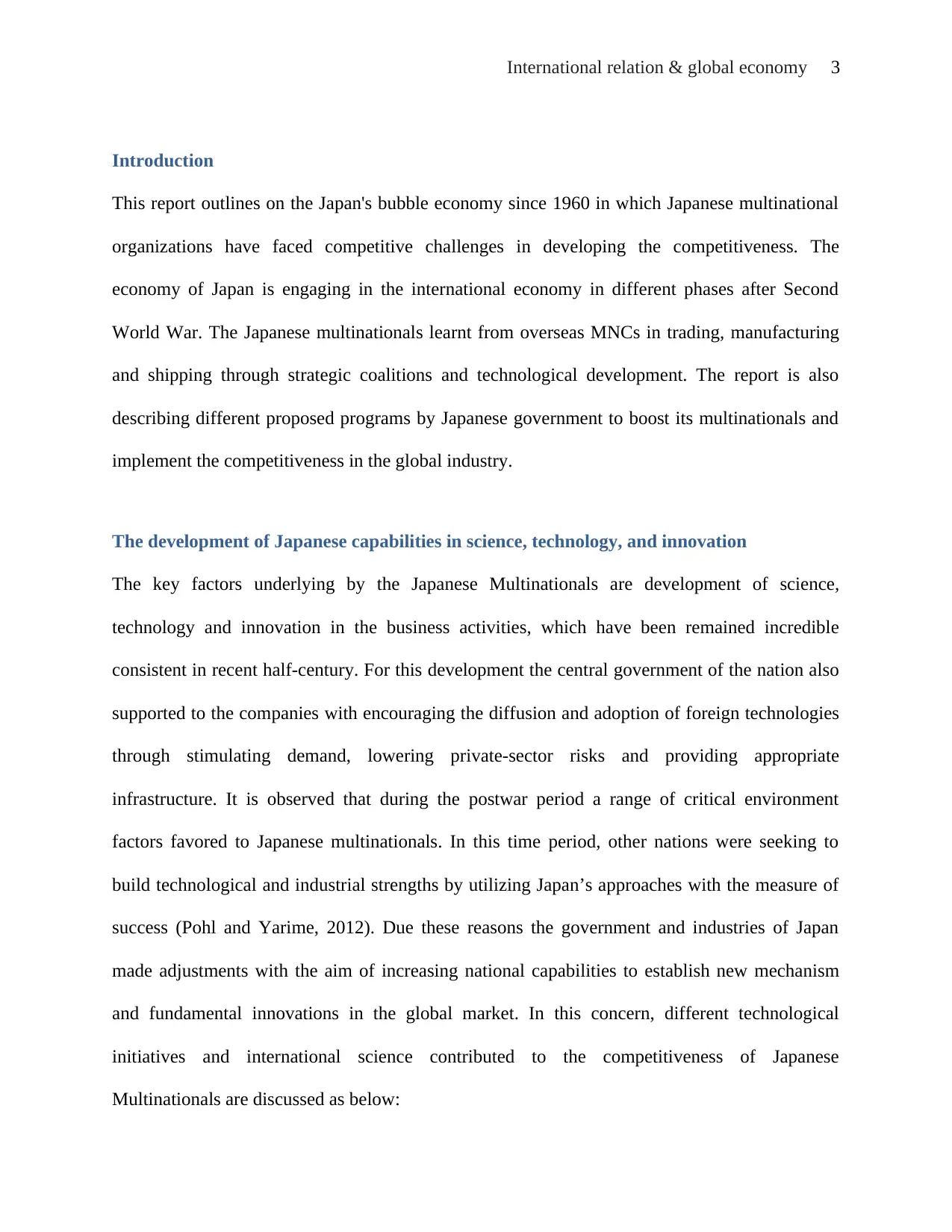
International relation & global economy 3
Introduction
This report outlines on the Japan's bubble economy since 1960 in which Japanese multinational
organizations have faced competitive challenges in developing the competitiveness. The
economy of Japan is engaging in the international economy in different phases after Second
World War. The Japanese multinationals learnt from overseas MNCs in trading, manufacturing
and shipping through strategic coalitions and technological development. The report is also
describing different proposed programs by Japanese government to boost its multinationals and
implement the competitiveness in the global industry.
The development of Japanese capabilities in science, technology, and innovation
The key factors underlying by the Japanese Multinationals are development of science,
technology and innovation in the business activities, which have been remained incredible
consistent in recent half-century. For this development the central government of the nation also
supported to the companies with encouraging the diffusion and adoption of foreign technologies
through stimulating demand, lowering private-sector risks and providing appropriate
infrastructure. It is observed that during the postwar period a range of critical environment
factors favored to Japanese multinationals. In this time period, other nations were seeking to
build technological and industrial strengths by utilizing Japan’s approaches with the measure of
success (Pohl and Yarime, 2012). Due these reasons the government and industries of Japan
made adjustments with the aim of increasing national capabilities to establish new mechanism
and fundamental innovations in the global market. In this concern, different technological
initiatives and international science contributed to the competitiveness of Japanese
Multinationals are discussed as below:
Introduction
This report outlines on the Japan's bubble economy since 1960 in which Japanese multinational
organizations have faced competitive challenges in developing the competitiveness. The
economy of Japan is engaging in the international economy in different phases after Second
World War. The Japanese multinationals learnt from overseas MNCs in trading, manufacturing
and shipping through strategic coalitions and technological development. The report is also
describing different proposed programs by Japanese government to boost its multinationals and
implement the competitiveness in the global industry.
The development of Japanese capabilities in science, technology, and innovation
The key factors underlying by the Japanese Multinationals are development of science,
technology and innovation in the business activities, which have been remained incredible
consistent in recent half-century. For this development the central government of the nation also
supported to the companies with encouraging the diffusion and adoption of foreign technologies
through stimulating demand, lowering private-sector risks and providing appropriate
infrastructure. It is observed that during the postwar period a range of critical environment
factors favored to Japanese multinationals. In this time period, other nations were seeking to
build technological and industrial strengths by utilizing Japan’s approaches with the measure of
success (Pohl and Yarime, 2012). Due these reasons the government and industries of Japan
made adjustments with the aim of increasing national capabilities to establish new mechanism
and fundamental innovations in the global market. In this concern, different technological
initiatives and international science contributed to the competitiveness of Japanese
Multinationals are discussed as below:
⊘ This is a preview!⊘
Do you want full access?
Subscribe today to unlock all pages.

Trusted by 1+ million students worldwide
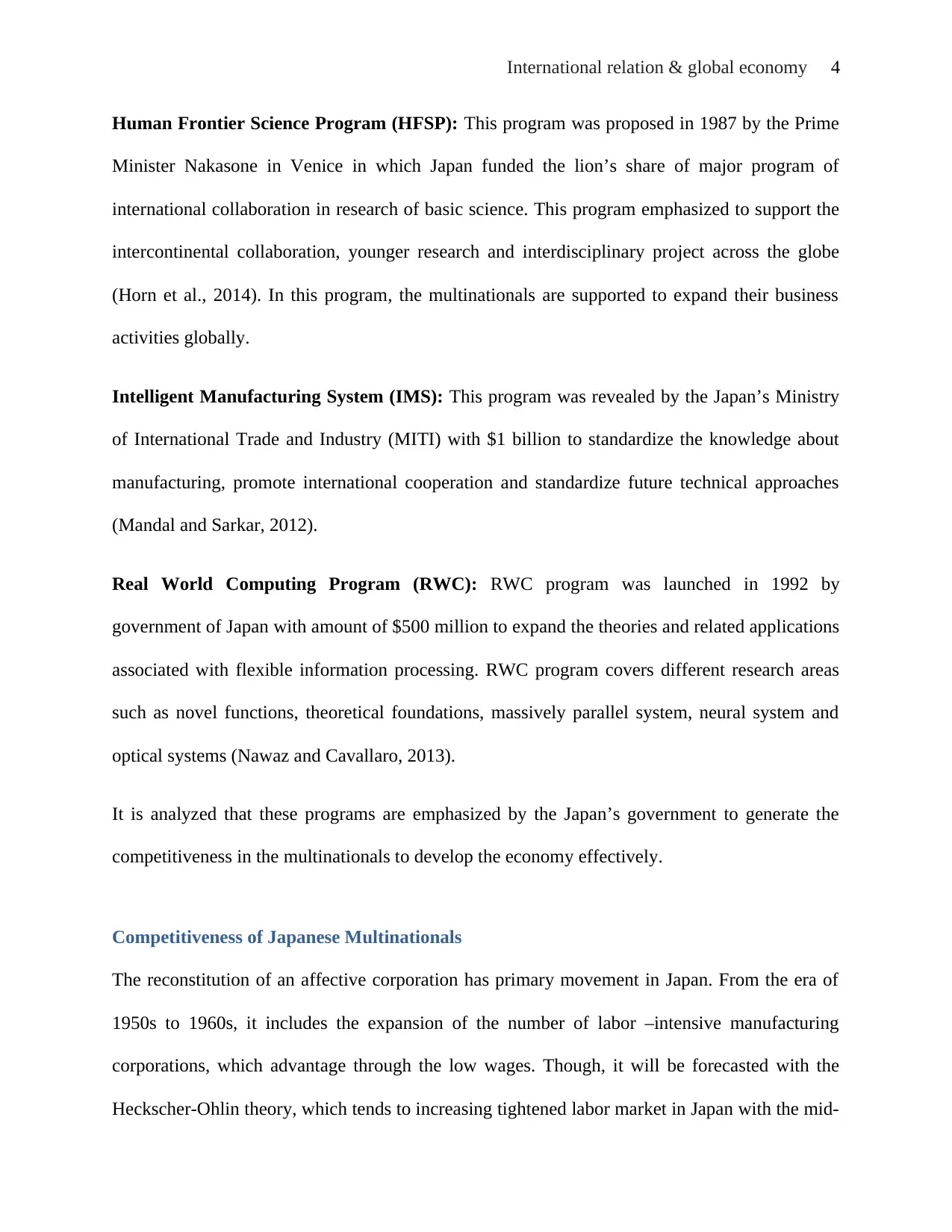
International relation & global economy 4
Human Frontier Science Program (HFSP): This program was proposed in 1987 by the Prime
Minister Nakasone in Venice in which Japan funded the lion’s share of major program of
international collaboration in research of basic science. This program emphasized to support the
intercontinental collaboration, younger research and interdisciplinary project across the globe
(Horn et al., 2014). In this program, the multinationals are supported to expand their business
activities globally.
Intelligent Manufacturing System (IMS): This program was revealed by the Japan’s Ministry
of International Trade and Industry (MITI) with $1 billion to standardize the knowledge about
manufacturing, promote international cooperation and standardize future technical approaches
(Mandal and Sarkar, 2012).
Real World Computing Program (RWC): RWC program was launched in 1992 by
government of Japan with amount of $500 million to expand the theories and related applications
associated with flexible information processing. RWC program covers different research areas
such as novel functions, theoretical foundations, massively parallel system, neural system and
optical systems (Nawaz and Cavallaro, 2013).
It is analyzed that these programs are emphasized by the Japan’s government to generate the
competitiveness in the multinationals to develop the economy effectively.
Competitiveness of Japanese Multinationals
The reconstitution of an affective corporation has primary movement in Japan. From the era of
1950s to 1960s, it includes the expansion of the number of labor –intensive manufacturing
corporations, which advantage through the low wages. Though, it will be forecasted with the
Heckscher-Ohlin theory, which tends to increasing tightened labor market in Japan with the mid-
Human Frontier Science Program (HFSP): This program was proposed in 1987 by the Prime
Minister Nakasone in Venice in which Japan funded the lion’s share of major program of
international collaboration in research of basic science. This program emphasized to support the
intercontinental collaboration, younger research and interdisciplinary project across the globe
(Horn et al., 2014). In this program, the multinationals are supported to expand their business
activities globally.
Intelligent Manufacturing System (IMS): This program was revealed by the Japan’s Ministry
of International Trade and Industry (MITI) with $1 billion to standardize the knowledge about
manufacturing, promote international cooperation and standardize future technical approaches
(Mandal and Sarkar, 2012).
Real World Computing Program (RWC): RWC program was launched in 1992 by
government of Japan with amount of $500 million to expand the theories and related applications
associated with flexible information processing. RWC program covers different research areas
such as novel functions, theoretical foundations, massively parallel system, neural system and
optical systems (Nawaz and Cavallaro, 2013).
It is analyzed that these programs are emphasized by the Japan’s government to generate the
competitiveness in the multinationals to develop the economy effectively.
Competitiveness of Japanese Multinationals
The reconstitution of an affective corporation has primary movement in Japan. From the era of
1950s to 1960s, it includes the expansion of the number of labor –intensive manufacturing
corporations, which advantage through the low wages. Though, it will be forecasted with the
Heckscher-Ohlin theory, which tends to increasing tightened labor market in Japan with the mid-
Paraphrase This Document
Need a fresh take? Get an instant paraphrase of this document with our AI Paraphraser
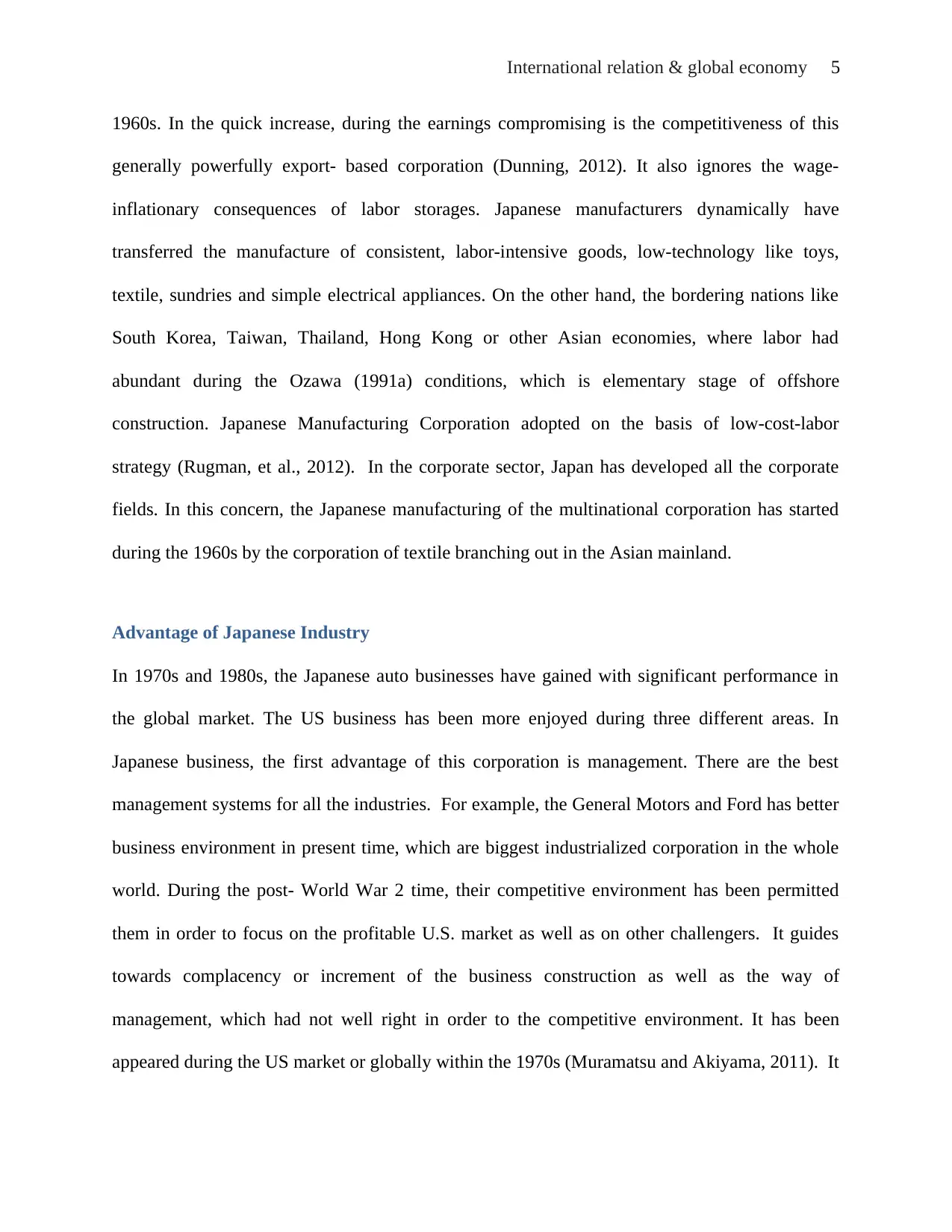
International relation & global economy 5
1960s. In the quick increase, during the earnings compromising is the competitiveness of this
generally powerfully export- based corporation (Dunning, 2012). It also ignores the wage-
inflationary consequences of labor storages. Japanese manufacturers dynamically have
transferred the manufacture of consistent, labor-intensive goods, low-technology like toys,
textile, sundries and simple electrical appliances. On the other hand, the bordering nations like
South Korea, Taiwan, Thailand, Hong Kong or other Asian economies, where labor had
abundant during the Ozawa (1991a) conditions, which is elementary stage of offshore
construction. Japanese Manufacturing Corporation adopted on the basis of low-cost-labor
strategy (Rugman, et al., 2012). In the corporate sector, Japan has developed all the corporate
fields. In this concern, the Japanese manufacturing of the multinational corporation has started
during the 1960s by the corporation of textile branching out in the Asian mainland.
Advantage of Japanese Industry
In 1970s and 1980s, the Japanese auto businesses have gained with significant performance in
the global market. The US business has been more enjoyed during three different areas. In
Japanese business, the first advantage of this corporation is management. There are the best
management systems for all the industries. For example, the General Motors and Ford has better
business environment in present time, which are biggest industrialized corporation in the whole
world. During the post- World War 2 time, their competitive environment has been permitted
them in order to focus on the profitable U.S. market as well as on other challengers. It guides
towards complacency or increment of the business construction as well as the way of
management, which had not well right in order to the competitive environment. It has been
appeared during the US market or globally within the 1970s (Muramatsu and Akiyama, 2011). It
1960s. In the quick increase, during the earnings compromising is the competitiveness of this
generally powerfully export- based corporation (Dunning, 2012). It also ignores the wage-
inflationary consequences of labor storages. Japanese manufacturers dynamically have
transferred the manufacture of consistent, labor-intensive goods, low-technology like toys,
textile, sundries and simple electrical appliances. On the other hand, the bordering nations like
South Korea, Taiwan, Thailand, Hong Kong or other Asian economies, where labor had
abundant during the Ozawa (1991a) conditions, which is elementary stage of offshore
construction. Japanese Manufacturing Corporation adopted on the basis of low-cost-labor
strategy (Rugman, et al., 2012). In the corporate sector, Japan has developed all the corporate
fields. In this concern, the Japanese manufacturing of the multinational corporation has started
during the 1960s by the corporation of textile branching out in the Asian mainland.
Advantage of Japanese Industry
In 1970s and 1980s, the Japanese auto businesses have gained with significant performance in
the global market. The US business has been more enjoyed during three different areas. In
Japanese business, the first advantage of this corporation is management. There are the best
management systems for all the industries. For example, the General Motors and Ford has better
business environment in present time, which are biggest industrialized corporation in the whole
world. During the post- World War 2 time, their competitive environment has been permitted
them in order to focus on the profitable U.S. market as well as on other challengers. It guides
towards complacency or increment of the business construction as well as the way of
management, which had not well right in order to the competitive environment. It has been
appeared during the US market or globally within the 1970s (Muramatsu and Akiyama, 2011). It

International relation & global economy 6
has been associated among the labor and management, industry or government and external and
manufacturers suppliers that was on arms length or frequently adversarial.
The second advantage of this corporation is benefited from the Japanese auto companies in cost
formation. On the other hand, the information that the earnings raises wrapped after the
efficiency, which expands provides a significant of Japanese auto organizations frame by the
1970s.
In the economy of global, some opportune trends also has favorable in order to the Japanese auto
business or hindered US manufacturers during the year of 1970s and 1980s. In 1970s the quick
increase within the oil price which front to better demand for small cares into the market of US
that Japanese organization had greater prepared in order to fill (Bahl, et al., 2012).
Support is provided by the auto industry of Japan to both the industries who has arguments with
industrial policy of Japan is considered as a solution to development of industries and with those
who has argued with marginal impact. In context of relationships of auto industry of Japan with
government, development of auto parts industry of Japan is deal in auto manufactures.
Motor Vehicle Production
1977 1982 1987 1992
World total (millions of vehicles) 40.9 36.1 45.9 47.7
North America 14.7 (36%) 8.7 (24%) 12.9 (28%) 12.7 (27%)
Europe 15.9 (34%) 14.8 (41%) 17.5 (38%) 17.5 (37%)
Asia 8.8 (22%) 11.2 (31%) 14.0 (31%) 14.6 (31%)
has been associated among the labor and management, industry or government and external and
manufacturers suppliers that was on arms length or frequently adversarial.
The second advantage of this corporation is benefited from the Japanese auto companies in cost
formation. On the other hand, the information that the earnings raises wrapped after the
efficiency, which expands provides a significant of Japanese auto organizations frame by the
1970s.
In the economy of global, some opportune trends also has favorable in order to the Japanese auto
business or hindered US manufacturers during the year of 1970s and 1980s. In 1970s the quick
increase within the oil price which front to better demand for small cares into the market of US
that Japanese organization had greater prepared in order to fill (Bahl, et al., 2012).
Support is provided by the auto industry of Japan to both the industries who has arguments with
industrial policy of Japan is considered as a solution to development of industries and with those
who has argued with marginal impact. In context of relationships of auto industry of Japan with
government, development of auto parts industry of Japan is deal in auto manufactures.
Motor Vehicle Production
1977 1982 1987 1992
World total (millions of vehicles) 40.9 36.1 45.9 47.7
North America 14.7 (36%) 8.7 (24%) 12.9 (28%) 12.7 (27%)
Europe 15.9 (34%) 14.8 (41%) 17.5 (38%) 17.5 (37%)
Asia 8.8 (22%) 11.2 (31%) 14.0 (31%) 14.6 (31%)
⊘ This is a preview!⊘
Do you want full access?
Subscribe today to unlock all pages.

Trusted by 1+ million students worldwide

International relation & global economy 7
Japan 8.5 (21%) 10.7 (30%) 12.2 (27%) 12.5 (26%)
Korea 0 0.2 1.0 1.7
Other Asia 0.3 0.3 0.8 0.4
Rest of the world 1.5 1.4 1.5 2.9
(Sources: Federal Communication Commission, 2017)
Steps required for improving the capabilities of fundamental research
Emphasis has been laid down on the importance of developing capability of developing original
technology (Ikegami, et al., 2011). A new series of programs has been launched for conducting
researches in new areas. Next Generation Basic Technology project has been launched for the
purpose of establishing a funding pool for consortia of industry in 1981. Due to high budget and
inefficiencies of companies, the project was taken back in the mid of 1980s. Apart from this, a
project having budget of $450 million for advancing the computing research has been launched
for the period of 10 years. Several concerns are raised by USA in concern of this project fearing
that the Japan will come further than USA using the advance level of technology. But the efforts
made by young researchers and other intangibles make the project complete and the\y succeeded
in developing that technology which is very significant technology in terms of commerce.
Another project that is investigated by Techno polis involves infrastructure of manufacturing
high technology and research and development in the targeted cities of Japan. Appearing results
from this project again seems suspicious.
Japan 8.5 (21%) 10.7 (30%) 12.2 (27%) 12.5 (26%)
Korea 0 0.2 1.0 1.7
Other Asia 0.3 0.3 0.8 0.4
Rest of the world 1.5 1.4 1.5 2.9
(Sources: Federal Communication Commission, 2017)
Steps required for improving the capabilities of fundamental research
Emphasis has been laid down on the importance of developing capability of developing original
technology (Ikegami, et al., 2011). A new series of programs has been launched for conducting
researches in new areas. Next Generation Basic Technology project has been launched for the
purpose of establishing a funding pool for consortia of industry in 1981. Due to high budget and
inefficiencies of companies, the project was taken back in the mid of 1980s. Apart from this, a
project having budget of $450 million for advancing the computing research has been launched
for the period of 10 years. Several concerns are raised by USA in concern of this project fearing
that the Japan will come further than USA using the advance level of technology. But the efforts
made by young researchers and other intangibles make the project complete and the\y succeeded
in developing that technology which is very significant technology in terms of commerce.
Another project that is investigated by Techno polis involves infrastructure of manufacturing
high technology and research and development in the targeted cities of Japan. Appearing results
from this project again seems suspicious.
Paraphrase This Document
Need a fresh take? Get an instant paraphrase of this document with our AI Paraphraser

International relation & global economy 8
In mid of 1980s, initiative including Centre of Key Technology, demonstrating projects for
telecommunications running combined by MITI and Ministry of Posts and Telecommunications
utilizing the proceedings from selling stock of Telephone and Telegram in the market.
Overseeing the work is done by the research organization having funds of 70% from Key
Technology Centre and rest of the funds is arranged by the companies participating in the
project. Companies having similarity in their objectives and competitive goals collaborates
various types of projects (Nakamura, 2011). Apart from MITI, in order to encourage
programmes for higher level of fundamental research and collaboration between different
sectors, several programmes are launched by various agencies.
Although, having a lot of number of initiatives for encouraging more fundamental research,
Japan still committing the programmes for raising funds for the purpose of conducting research
in the field of science and engineering (Zhang, et al., 2011). Structural changes are also
implemented in the universities of Japan using this method.
Conclusion
From the above discussion it can be concluded that the Japanese Multinationals played an
important role in developing the global economy. The Japanese Multinationals developed the
business scenario through technological development and innovations since 1960s. Hence, it is
analyzed that the Japanese Multinationals have good contribution in the development of global
economy.
In mid of 1980s, initiative including Centre of Key Technology, demonstrating projects for
telecommunications running combined by MITI and Ministry of Posts and Telecommunications
utilizing the proceedings from selling stock of Telephone and Telegram in the market.
Overseeing the work is done by the research organization having funds of 70% from Key
Technology Centre and rest of the funds is arranged by the companies participating in the
project. Companies having similarity in their objectives and competitive goals collaborates
various types of projects (Nakamura, 2011). Apart from MITI, in order to encourage
programmes for higher level of fundamental research and collaboration between different
sectors, several programmes are launched by various agencies.
Although, having a lot of number of initiatives for encouraging more fundamental research,
Japan still committing the programmes for raising funds for the purpose of conducting research
in the field of science and engineering (Zhang, et al., 2011). Structural changes are also
implemented in the universities of Japan using this method.
Conclusion
From the above discussion it can be concluded that the Japanese Multinationals played an
important role in developing the global economy. The Japanese Multinationals developed the
business scenario through technological development and innovations since 1960s. Hence, it is
analyzed that the Japanese Multinationals have good contribution in the development of global
economy.
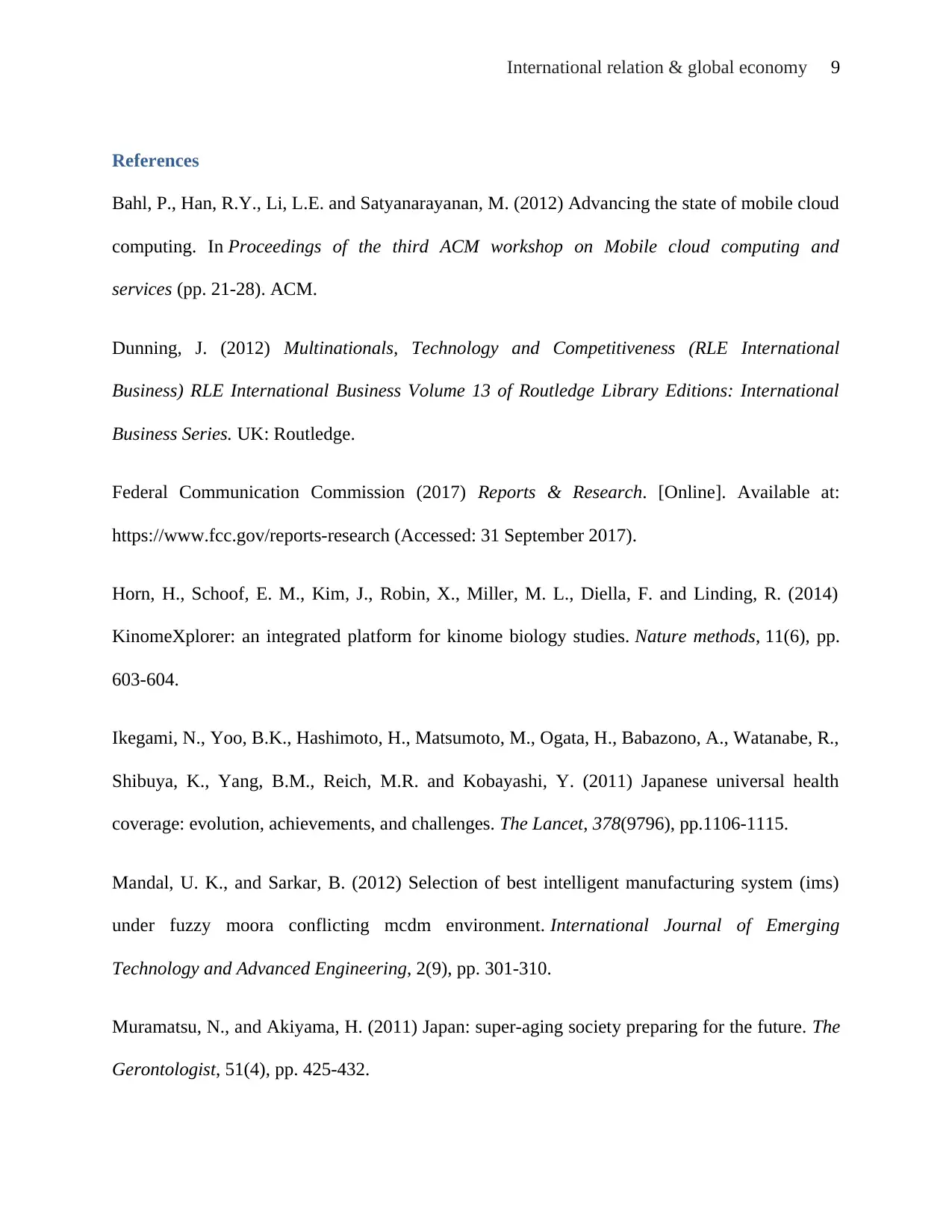
International relation & global economy 9
References
Bahl, P., Han, R.Y., Li, L.E. and Satyanarayanan, M. (2012) Advancing the state of mobile cloud
computing. In Proceedings of the third ACM workshop on Mobile cloud computing and
services (pp. 21-28). ACM.
Dunning, J. (2012) Multinationals, Technology and Competitiveness (RLE International
Business) RLE International Business Volume 13 of Routledge Library Editions: International
Business Series. UK: Routledge.
Federal Communication Commission (2017) Reports & Research. [Online]. Available at:
https://www.fcc.gov/reports-research (Accessed: 31 September 2017).
Horn, H., Schoof, E. M., Kim, J., Robin, X., Miller, M. L., Diella, F. and Linding, R. (2014)
KinomeXplorer: an integrated platform for kinome biology studies. Nature methods, 11(6), pp.
603-604.
Ikegami, N., Yoo, B.K., Hashimoto, H., Matsumoto, M., Ogata, H., Babazono, A., Watanabe, R.,
Shibuya, K., Yang, B.M., Reich, M.R. and Kobayashi, Y. (2011) Japanese universal health
coverage: evolution, achievements, and challenges. The Lancet, 378(9796), pp.1106-1115.
Mandal, U. K., and Sarkar, B. (2012) Selection of best intelligent manufacturing system (ims)
under fuzzy moora conflicting mcdm environment. International Journal of Emerging
Technology and Advanced Engineering, 2(9), pp. 301-310.
Muramatsu, N., and Akiyama, H. (2011) Japan: super-aging society preparing for the future. The
Gerontologist, 51(4), pp. 425-432.
References
Bahl, P., Han, R.Y., Li, L.E. and Satyanarayanan, M. (2012) Advancing the state of mobile cloud
computing. In Proceedings of the third ACM workshop on Mobile cloud computing and
services (pp. 21-28). ACM.
Dunning, J. (2012) Multinationals, Technology and Competitiveness (RLE International
Business) RLE International Business Volume 13 of Routledge Library Editions: International
Business Series. UK: Routledge.
Federal Communication Commission (2017) Reports & Research. [Online]. Available at:
https://www.fcc.gov/reports-research (Accessed: 31 September 2017).
Horn, H., Schoof, E. M., Kim, J., Robin, X., Miller, M. L., Diella, F. and Linding, R. (2014)
KinomeXplorer: an integrated platform for kinome biology studies. Nature methods, 11(6), pp.
603-604.
Ikegami, N., Yoo, B.K., Hashimoto, H., Matsumoto, M., Ogata, H., Babazono, A., Watanabe, R.,
Shibuya, K., Yang, B.M., Reich, M.R. and Kobayashi, Y. (2011) Japanese universal health
coverage: evolution, achievements, and challenges. The Lancet, 378(9796), pp.1106-1115.
Mandal, U. K., and Sarkar, B. (2012) Selection of best intelligent manufacturing system (ims)
under fuzzy moora conflicting mcdm environment. International Journal of Emerging
Technology and Advanced Engineering, 2(9), pp. 301-310.
Muramatsu, N., and Akiyama, H. (2011) Japan: super-aging society preparing for the future. The
Gerontologist, 51(4), pp. 425-432.
⊘ This is a preview!⊘
Do you want full access?
Subscribe today to unlock all pages.

Trusted by 1+ million students worldwide

International relation & global economy 10
Nakamura, A. (2011) MITI and the Japanese Miracle Revisited: Reevaluation of the
Administrative‐Centered Government. Public Administration Review, 71(6), pp. 931-933.
Nawaz, T., and Cavallaro, A. (2013) A protocol for evaluating video trackers under real-world
conditions. IEEE Transactions on Image Processing, 22(4), pp. 1354-1361.
Pohl, H., and Yarime, M. (2012) Integrating innovation system and management concepts: The
development of electric and hybrid electric vehicles in Japan. Technological Forecasting and
Social Change, 79(8), pp. 1431-1446.
Rugman, A.M., Oh, C.H. and Lim, D.S., (2012) The regional and global competitiveness of
multinational firms. Journal of the Academy of Marketing Science, 40(2), pp.218-235.
Zhang, Y., Yu, R., Xie, S., Yao, W., Xiao, Y. and Guizani, M. (2011) Home M2M networks:
architectures, standards, and QoS improvement. IEEE Communications Magazine, 49(4).
Nakamura, A. (2011) MITI and the Japanese Miracle Revisited: Reevaluation of the
Administrative‐Centered Government. Public Administration Review, 71(6), pp. 931-933.
Nawaz, T., and Cavallaro, A. (2013) A protocol for evaluating video trackers under real-world
conditions. IEEE Transactions on Image Processing, 22(4), pp. 1354-1361.
Pohl, H., and Yarime, M. (2012) Integrating innovation system and management concepts: The
development of electric and hybrid electric vehicles in Japan. Technological Forecasting and
Social Change, 79(8), pp. 1431-1446.
Rugman, A.M., Oh, C.H. and Lim, D.S., (2012) The regional and global competitiveness of
multinational firms. Journal of the Academy of Marketing Science, 40(2), pp.218-235.
Zhang, Y., Yu, R., Xie, S., Yao, W., Xiao, Y. and Guizani, M. (2011) Home M2M networks:
architectures, standards, and QoS improvement. IEEE Communications Magazine, 49(4).
1 out of 10
Related Documents
Your All-in-One AI-Powered Toolkit for Academic Success.
+13062052269
info@desklib.com
Available 24*7 on WhatsApp / Email
![[object Object]](/_next/static/media/star-bottom.7253800d.svg)
Unlock your academic potential
© 2024 | Zucol Services PVT LTD | All rights reserved.





